Deepavali (“avali” means rows and “deepa” means lamp) or Diwali is a festival of lights much loved by one and all. It is the time for sweets, savories, family get-together, new clothes, crackers and the most important of them all lights. Diwali is spread over 5 days and the first 3 days falls in the Hindu month of Ashwina and the next 2 days falls in Karthika, which is usually November in the Gregorian calendar. This is one of the major festivals in India and it is celebrated all over India and Nepal with a lot enthusiasm. Many legends are associated with this festival.
The reason for celebrating this festival varies from region to region and religion to religion. But one reason remains the same and that is of triumph of “good” over “evil” and the elevating of spiritual darkness. This festival is mentioned in the great epic Ramayana. For the festival date click here.
This year (2015), Diwali is celebrated in November:
Day1 – (Ashwina Month / Tryodashi Day) – Dhanteras, Neeru thumbuva habba
Day2 – (Ashwina Month / Chathurdashi Day) – Narakachathurdashi, Choti Diwali
Day3 – (Ashwina Month / Amavasya Day) – Lakshmi Pooja, Amavasya
Day4 – (Karthika Month / Padya Day) – Balipadyami, Vikram Samvat(New Year), BaliPratipada
Day5 – (Karthika Month / Bidige – Dwithiya(2nd day of Karthika)) – Bhai Duj/Bhau Bij.
Markets look their best with flowers, decoration materials, sweets and crackers on display.
Picture1 – Crackers arranged in a shop
Celebration in different regions
North India
North Indians celebrate the return of Lord Rama from his 14-year exile to Ayodhya after defeating the 10-headed demon Ravana in Lanka. To welcome their king back, the whole of Ayodhya was lit up with rows of lamps during this time. Hence, even now innumerable diya/oil lamps are arranged inside and outside the house during this festival season. The houses are cleaned, newly painted and decorated with flowers.
Picture2 – Lamps arranged inside the house
Day1 is called as Dhanteras. On this day it is believed that Dhanvantri the Gods physician came out of the ocean with a pot in his hand filled with “Amrith”/life saving nectar. New utensils, gold or silver are bought and worshiped on this day.
Day2 is Choti Diwali, this is celebrated with less lights lit and lesser crackers burst.
Day3 is Amavasya/no-moon day and businessmen start their new account by doing elaborate Lakshmi pooja in their business establishments. Colorful Rangoli/Patterns adorn the house along with diyas/lamps. Crackers are burst and delicious food is prepared. It is believed that on this day Lakshmi the goddess of wealth emerged from the ocean during the samudra manthan/whipping of the ocean.
Picture 3- Crackers
Day4 is celebrated as “Govardhan Pooja” or “Annakoot”. This is to commemorate Lord Krishna’s win over Indra. Krishna lifted the Govardhan mountain on his tiny finger to save the people from the fury of Lord Indra’s rain. On this day, a mountain of food is decorated to represent the Govardhan mountain.
Bhai Duj is celebrated on Day5, where sisters apply vermilion colored powder on the foreheads of their brothers and pray for their long and happy life. Both married and unmarried sisters celebrate this.
East India
Goddess Kali is worshiped during Diwali. It is believed that on this day Goddess Kali killed the wicked demons Shumbha and Nishumbha. The pooja is performed at midnight on Amavasya/no-moon day with great devotion. People pray for happiness and prosperity. Homes are decorated and elaborate Rangoli/Patterns are drawn in front of houses and courtyards.
Picture4 – Rangoli
West and Central India
Diwali is celebrated for 5 days and the shopping, cleaning and cooking sweets and savories start few weeks before the festival. It is celebrated with elaborate pooja to goddess Lakshmi and beautiful Rangoli and lamps welcome the goddess of wealth. Small footprints are drawn using rice flour and vermilion powder paste all around the house depicting Goddess Lakshmi’s presence in the house.
Picture5 – Lakshmi Pooja
Day4 is celebrated as Vikram Samvat(New Year) and families and friends visit one another and wish each other and exchange sweets.
Some of the dishes prepared during this festival are Sohan Papdi, Mawa Kachori, Besan Laddoo, Jalebi, Shankarpara, Gonth Ke Laddoo, Til Ke Laddoo etc.,
Maharashtra and Goa
Diwali celebration in Maharashtra is again celebrated for 5 days. Day1 is Dhanteras. On this day the women of the house with great devotion perform “Yama-diya-daan”. The women make one diya/lamps using kneaded flour/dough for every living male member of the family. In the evening the lamps are lit and offered to the god of death Yama and the women pray for a long life of their men folk.
Day2 is Narakachaturdashi, it is the day when Lord Krishna eliminated the wicked demon Narakasura/demon of hell and liberated 16,000 women who were imprisoned by the demon. People in this region take a special bath before sunrise called ‘”Abhyang-snan“. On this day they massage their body with scented herbal powder called “Uptan” before the bath.
Day3 is Amavasya, on this day Goddess Lakshmi is worshiped with great devotion and light lamps outside homes. They also follow the custom of hanging the “Akash-kandil”/sky-lamp, which is prepared using colorful paper in the verandah. Lord Ganesh, cash, jewelry and the broom are also worshiped. Sweets and savories like Chivda, Anaras, Karanji, Shev, Chirote, Chakkali, Shankarpole are prepared.
Picture6 – Chakkali, Chivda, Karanji
Day4 is Padya, which is known as “Diwalicha Padya” or “BaliPratipada” . This day is the celebration of the togetherness and love shared by husband and wife.
Day5 is called “Bhau Bij”. It is same as Bhai Duj celebrated in North India.
South India
Apart from Kerala the other states in the south like Karnataka, Andhra Pradesh and Tamil Nadu celebrate Deepavali with festive food, rangoli, lamps and crackers. The festival starts on the triyodashi (Day1), which t is known as “Neeru thumbuva Habba”/water filling festival in Karnataka. On this day in the evening the bathrooms are cleaned and scrubbed and using Lime, Flowers and Rangoli powder, the bathroom is well decorated. Water is filled in pots and an idol of Lord Ganesha is kept on a water pot and worshiped. This begins the festivities for the next 3 days.
Day2 is celebrated as Narakachaturdashi. People wake up before sunrise clean the courtyard in front of the house and draw patterns using rangoli/white powder and take an oil bath. It is believed that by doing so it is as good as taking bath in the Ganges. Before the bath all the members of the family sit on a mat on the floor and the oldest lady of the house performs “Yenne Shastra”/Oil ritual where she applies tilak/vermilion colored powder on the forehead and then dips a gold finger ring into the scented oil bowl and applies it on the head, hands and feet of each individual. An aarathi (using water, lime, Turmeric powder) is performed to everyone and they all pay obeisance to the god and elders and take head bath. They wear new clothes and burst crackers. In the evening again crackers are burst to signify the end of evil. A festive spread / Habbada Adige is prepared comprising of Payasa, Chitranna, Kosambari, Palya, Holige, Ambode etc.,
Day3 is Amavasya and is celebrated with Lakshmi pooja.
Day4 is Balipadyami, and this falls on the Padya of the hindu month of Karthika. The legend narrates that on this day the arrogant king Bali was pushed into the netherworld by Lord Vishnu, who appeared in the form of a Brahmin boy Vamana (one of the ten incarnations of Lord Vishnu). Another festival called Onam is celebrated to commemorate king Bali in Kerala. “Bali Chakravarthi Kotte”/King Bali’s representation is prepared using cow dung and a marigold is stuck on it and this is kept in the pooja room and worshiped. Many “keraka” again made of cow dung with a marigold on it are kept near all the doors and worshipped.
Delicious food is prepared and all the family members sit together and relish the food. The same evening “Balindra pooja” is performed. To perform this, spread some rice on a plate and imprint a swastika on it using fingers. On this keep a kalasha and an idol of Lord Krishna in front of the kalasha and perform the pooja. The sky comes alive with fireworks and the atmosphere resounds with crackers being burst. On this day houses are decorated with lamps both inside and outside.
Picture7 – Fireworks
From the next day onwards till the end of Karthika month, two lamps are kept in front of the Tulasi plant and two lamps in front of the house. Nowadays, floating candles and flowers can be used to decorate homes.
Diwali celebrations come to an end in South India and Maharashtra on Uthandwadashi (12th day of Karthika month). For the festival date click here. On this day “Tulasi Maduve/Vivah/Marriage” is celebrated. Tulasi/Basil plant is married to Lord Krishna on this day. An idol of Krishna is kept next to the decorated Tulasi plant along with an Indian Gooseberry stalk and worshipped.
Picture8 – Tulasi Maduve
An aarathi is performed using 5 Gooseberries as a stand for the wick and neighbors and friends are invited to take part in the ritual. Songs on Tulasi are sung while doing aarathi. An offering of either Kosambari or Usali/Gugri is prepared and distributed.
Picture9 – A decorated aarathi plate
For the festival date click here.
For festival food recipes click here.
For festival snacks and drinks recipes click here.
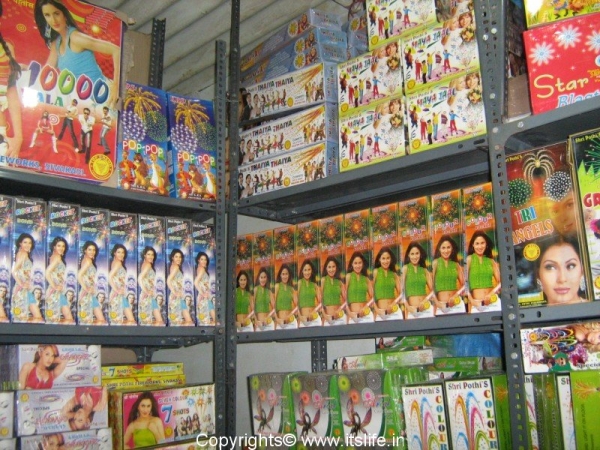
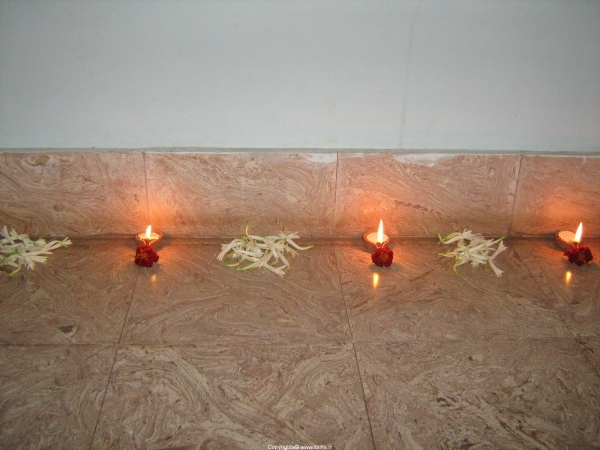
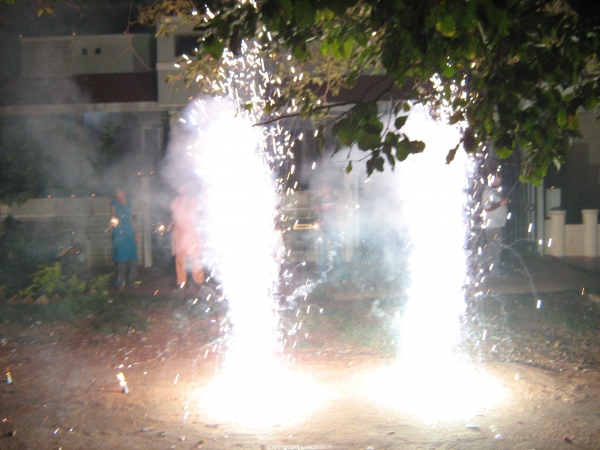
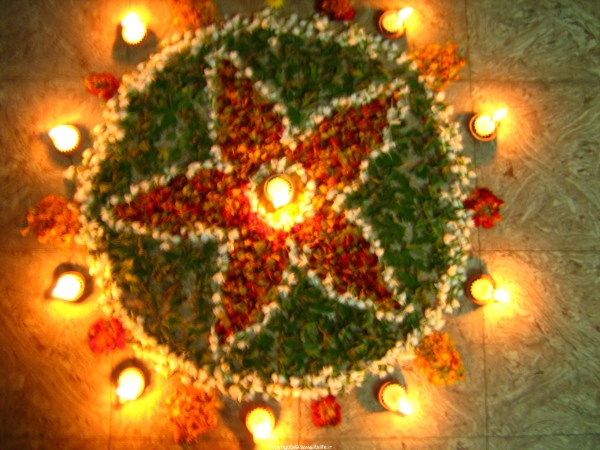
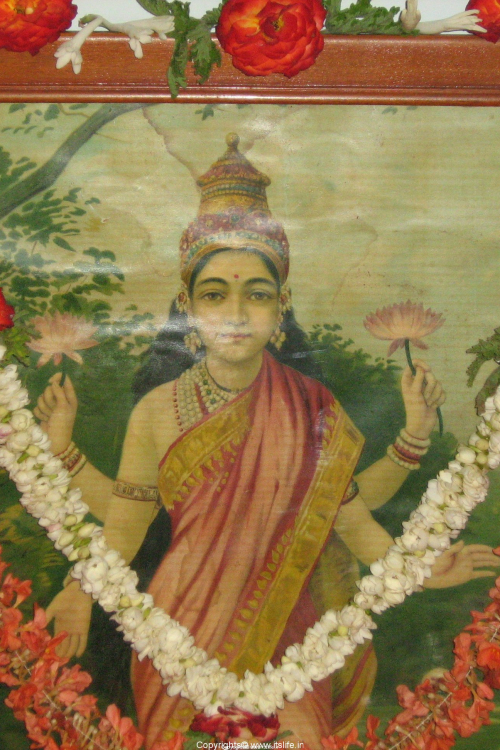
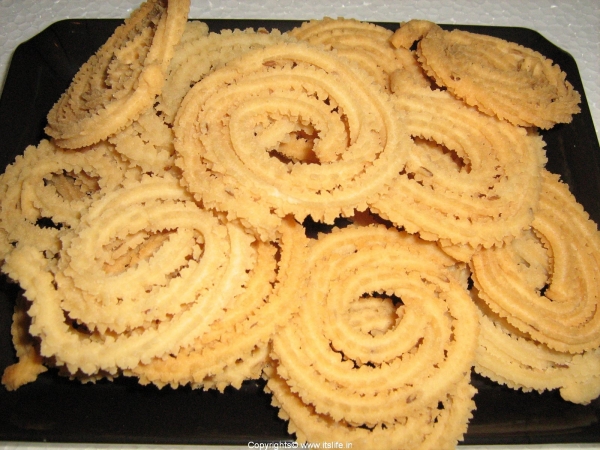
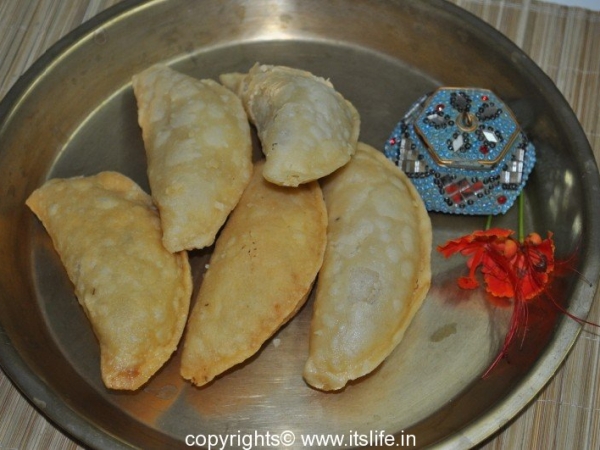
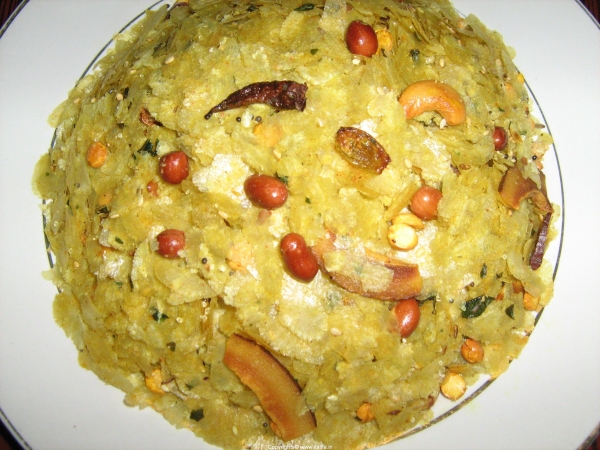
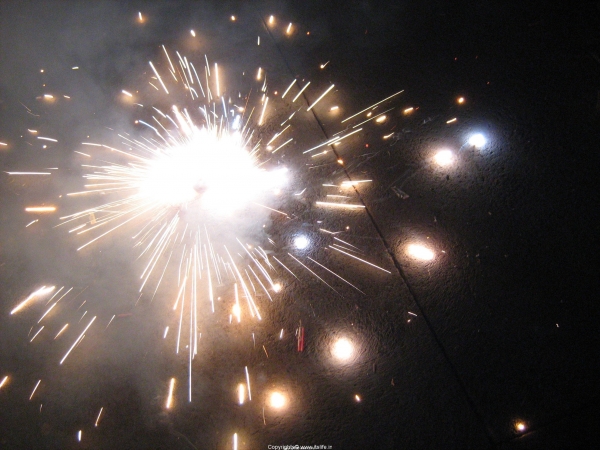
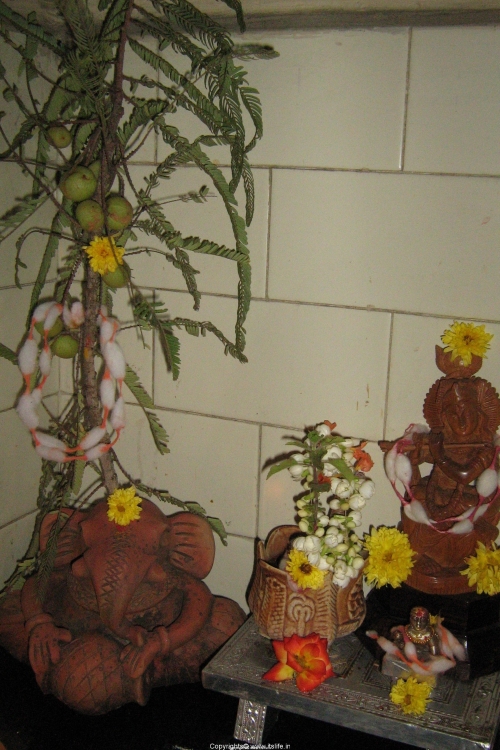
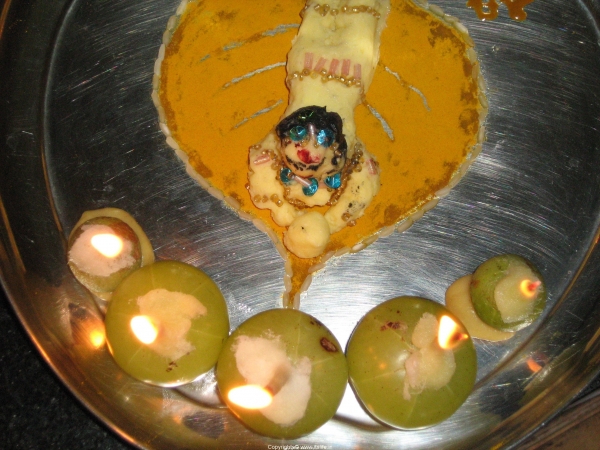
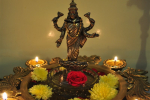
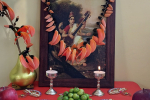
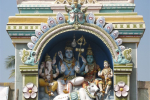
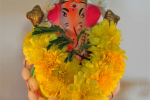
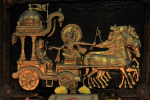
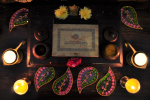
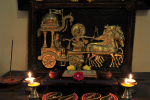

you have a great site. keep up the good work.
Sankar
i am searching for deepavali wishes which i can’t find in this site but apart from all site is too good keep it up
Hi this is good festival because it give many holiday…..and we enjoy it
how to decorate aarthi plates?
would u write about arthi designs
Hi Namita, Aarathi plates can be decorated in various ways using flowers, lentils or Turmeric and Kumkum. The aarathi plate that you see in this post is a crawling Krishna molded out of butter and kept in fridge for some time. For the leaf – wet the plate in the pattern of a leaf and sprinkle Turmeric powder over it and using a tooth pick draw the veins.
Happy Diwali.
Shantha
how to perform dhanvantari pooja ‘n’ lakshmi pooja
what is the significance of havn ‘kuberan seru’ how is kuber pooja done?
i had a wonderful dasara…..thanx to itslife!
Hi Namita, About Dhanvantri, I quote from the above article “Day1 is called as Dhanteras. On this day it is believed that Dhanvantri the Gods physician came out of the ocean with a pot in his hand filled with “Amrith” / life saving nectar. New utensils, gold or silver are bought and worshiped on this day.” Lakshmi Pooja – Worship with flowers, kumkum and turmeric powder and offer fruits as naivedya. Draw a colorful rangoli, light lamps and burst crackers. Kuber Pooja – I have never performed this, but I know he is a mythological character who is supposed to… Read more »
Hi Shantha,
Awesome information on ‘Deepavali’..
Yava vrathakke yava recipe, andre saraswathi pooje ge we make sweet dosa/yeriappa, similarly bere vrathagalige yava recipes anta dayavittu post madi..
u never know i m maintaining a big diary to write down ur recipes/vrathas/tips/general information which is almost complete and have to take a new one..

Thanks,
Nagashree.
Thanks Nagashree. You will find the information you are looking for in the Dasara post.
Regards,
Shantha
happy deepavali Shantha…
Thank u madam, you have covered extensive information on Balipadyami covering all parts of India.
Really worthful and educative. One should read this and communicate to their children to know our customs and their background to do so and follow the rituals.
Thanks Manjunath for leaving this encouraging note.
Yes it’s a very good site but please keep it updated always. It’s my humble request please consider it.
Sure, Rajani. I have tried my best to post regularly.
Thanks for visiting.
We used to sing Balindrana Rajyakke Honno Honnu and sprinkle marigold petals on each other. Do you know the verses in full. I only remember the last phrase.
Does it go something like this:
Halu hallavagi, bhoomi bettavgi,Balindrana rajya Subkishvagi irili… Balindrana Rajyakke Honno honnu.